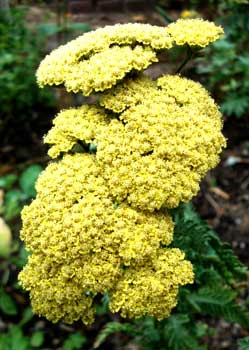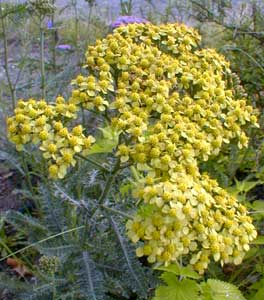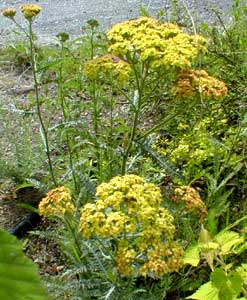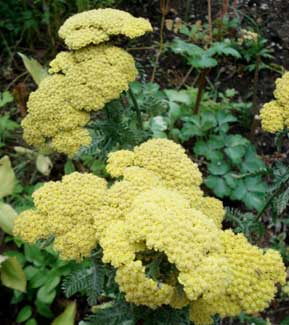
'Moonshine' Yellow Milfoil:
Easy & Hardy
"Day by day through the dust & heat have we thirsted;
Day by day through stony ways have we hungered;
Naught but a few bitter herbs that grew by the wayside."
-Wilbur Underwood
(1874-1935)
(1874-1935)
 Common yarrow or milfoil has numerous folknames, including carpenter's herb, sanguinary, staunchgrass, soldier's woundwort, or bloodwort. It has been in English & European gardens since the Middle Ages or longer, & was valued for medicinal properties from ancient times. The name Yarrow is derived from the Saxon "gearwe" which means literally "completeness" or "effective," an evident allusion to its curative powers.
Common yarrow or milfoil has numerous folknames, including carpenter's herb, sanguinary, staunchgrass, soldier's woundwort, or bloodwort. It has been in English & European gardens since the Middle Ages or longer, & was valued for medicinal properties from ancient times. The name Yarrow is derived from the Saxon "gearwe" which means literally "completeness" or "effective," an evident allusion to its curative powers.It likes dry open places & is a good plant for neglected half-wild areas of a meadow, xeriscape garden, or streetside. It prefers a dryish poor soil, & will not look its best if overwatered or in too rich a soil. It'll stunt if not watered at all during particularly dry heatwaves, but it's a hard one to kill, except in winter when during dormancy it can rot out due to heavy rainfall.
Eurasian Yarrows of the species Achillea millefolium are mainly pink to lavender, but many variant races & sports have been used to cultivate yarrows of all colors, notably bright-bright yellow, white, & sundry shades of reds. Hybridization with other species such as the small bright yellow A. cypeolata from Roumania, & the pale yellow A. taygetea, has helped extend the color range of yarrows.
 The cultivar 'Moonshine' is a Blooms of Bressingham introduction from England, & a recipient of the Award of Garden Merit. Though very often categorized simply as an A. millefolium cultivar, it was in the main developed by hybridizing the two main yellow species, A. clypeolata & A. taygetea. It has for many years remained the most commonly offered yellow yarrow.
The cultivar 'Moonshine' is a Blooms of Bressingham introduction from England, & a recipient of the Award of Garden Merit. Though very often categorized simply as an A. millefolium cultivar, it was in the main developed by hybridizing the two main yellow species, A. clypeolata & A. taygetea. It has for many years remained the most commonly offered yellow yarrow.The name 'Moonshine' may be intended only to evoke golden moonlight. But it seems also to be a pun on illicite home-brewed liquor, because yarrow has long been used as a flavoring in alcoholic beverages.
Yarrow was a component of beer & wine production in the middle ages. Today an extract is still used as a commercial flavoring in beer or other adult beverages so long as the finished beverage product is free of thujone, this being the chemical best known as Wormwood's primary toxin, which makes absinthe a dangerous & outlawed adult beverage.
Thujone is the bitterest component of yarrow's leaves, which keeps it little-browsed by wild animals. It's a component of many edible plants such as sassafrass, pennyroyal, thyme, caraway, & sage, most of which are harmless unless used internally with compulsive regularity.
The thujone can also function as a growth suppressant for surrounding perennials, giving yarrow an "edge" or taking over a location. Most perennials don't mind it, but the more sensitive herbs may not like yarrow as a companion.
 This is a clumping perennial that spreads by rhizomes to two feet width, & which stands a foot & a half to two feet tall when in flower, which is a bit shorter than most yarrows. Yellow blooms rise above the silvery-green foliage beginning as early as May, certainly by June, & with deadheading can continue into early autumn.
This is a clumping perennial that spreads by rhizomes to two feet width, & which stands a foot & a half to two feet tall when in flower, which is a bit shorter than most yarrows. Yellow blooms rise above the silvery-green foliage beginning as early as May, certainly by June, & with deadheading can continue into early autumn.Although yarrow self-seeds with ease, one never knows what one will get color-wise, & favorite yarrows should be propagated by division to preserve a particular color. When a clump is large enough to divide, late spring is the time to do it.
Yarrow's basal leaves, but not its upper stems, are semi-evergreen, though often with such stringy leaves they are not invariably good looking for a winter garden, unless one knows the following trick.
When it seems time to deadhead after the last flourish of summer & early autumn flowers, trim the majority of the yarrow foliage to a half-foot height. It returns immediately, but with basal leaves only, presenting as a shorter more compact plant which will have shorter flower stems for its final mid-autumn rebloom. Then whatever remains of the leaves lasts through winter as a tidy & fern-like clump, rather than a floppy half-dead-looking plant.
The tallest yarrows have a tendency to tip over, especially when blooms are very numerous & heavy. Other clumping perennials nearby will help prop up the flower stems of sundry yarrows. We have very upright Purple Giant Hyssop planted amidst the yarrows for this purpose, & the hyssops seem never to been out-competed. However, "Moonshine" is shorter & more compact than most yarrows, so less a worry since not inclined to tip unless overwatered.
Continue to:
'Paprika' Yarrow